
Transcription
California State Senate
SENATOR
HOLLY J. MITCHELL
THIRTIETH SENATORIAL DISTRICT
August 30, 2016,
Mr. Edwin J. Hutchison
CDCR No. P-68859 / Housing 1-N-34
CSP-SQ / 1 Main Street
San Quentin, CA 94974
Dear Mr. Hutchison,
Thank you for contacting my office regarding your request for information on Governor Brown's 2016 ballot initiative on prison reform and your commitment to serving juveniles as a restorative justice facilitator.
I am providing you with the following information:
- THE PUBLIC SAFETY AND REHABILITATION ACT OF 2016
- An overview of Proposition 57 written by Ballotpedia
- Recent article on Proposition 57 published in the Los Angeles Times Newspaper
Thank you again for contacting my office.
Demand more,
H Mitchell
Senator Holly Mitchell
30th Senate District
8/30/2016 Gov. Brown's parole measure can go on November ballot, state Supreme Court rules - LA Times
Gov. Brown's parole measure can go on November ballot, state Supreme Court rules
[photo]
Gov. Jerry Brown wants voters to approve a plan designed to reduce the state's prison population. (Associated Press)
By Maura Dolan and Paige St. John
June 6, 2016, 5:45 PM
Californians likely will be asked to decide in November whether to expand parole to thousands more inmates in what would be the state's biggest change in sentencing law in decades.
The proposed reworking of the parole system cleared a key hurdle Monday, when the California Supreme Court ruled 6-1 that the proponents of a ballot measure backed by Gov. Jerry Brown did not violate a state election law. The ruling, a victory for Brown, gives the attorney general wide latitude to accept last-minute, major changes to proposed initiatives.
ADVERTISING
If enough petition signatures are validated, a measure would be placed on the fall ballot to allow a parole board to consider t=early release for thousands of inmates not currently eligible for parole -- a step Brown has said is needed to comply with a federal court order to reduce the prison population.
Brown's proposal is the latest of several recent measures intended to reduce lengthy sentences in the state. In 2011, the state shifted lower-level prison felons to county jails, worsening local overcrowding and forcing widespread local releases but only temporarily reducing the prison population.
A year later, voters passed a measure to limit the tough three-strikes sentencing law. A third strike must be violent to justify a life sentence.
In 2014, voters adopted a measure that reduced some felonies to misdemeanors. Certain drug possession felonies became misdemeanors, as did petty theft, receiving stolen property and writing bad checks for less than $950. That measure led to the release of 4,000 inmates.
But Brown's proposal goes further. Nearly four decades after signing a law requiring strict sentences - a move that Brown now laments had "unintended consequences" - he wants voters to permit a possible early release on parole of felons whose primary crime was nonviolent.
The tough-on-crime laws of previous decades, including the one Brown signed, produced severely overcrowded prisons, and the state is under a federal court mandate to bring down the prison population.
To accomplish this, Brown would vastly expand parole opportunities.
Inmates would be eligible for parole after serving only the sentence for their core crime, negating time tacked on for gang membership, a gun or prior offenses.
Inmates would also receive increased credits for good behaviour, and a judge, instead of a prosecutor, would decide whether to try someone as young as 14 in juvenile court or adult court.
"By allowing parole consideration if they do good things, they will then have an incentive... to show those who will be judging whether or not they're ready to go back into society," Brown said in announcing his plan.
The conservative Criminal Justice Legal Foundation has estimated that 42,000 inmates would be eligible for early parole under the initiative.
Under threat of court-ordered mass releases, the state now relies on contracts to hold thousands of inmates in private prisons as far away as Mississippi. But the prison population is once again rising, after reaching a low of 127,272 in February.
A year ago the governor telephoned Mike Ramos, the chief prosecutor for San Bernardino County, telling him: "We've got a problem. Your county is sending too many people to prison."
Ramos said he tried to discourage Brown from launching what would be another major shock wave to local law enforcement agencies.
"I understand where the governor is coming from," Ramos said, "but generally speaking this initiative is going to put career criminals back on the streets."
Former Gov. Pete Wilson called Brown's prison crowding solution "a great leap backwards." He said the initiative overrides decades of penalties added by lawmakers under multiple governors, including himself, in answer to specific crimes.
So-called enhancements include the two to four years added to sentences for gang-related crimes, and five to 25 years tacked on to crimes where a gun is used. The terms for the enhancements can exceed the sentence for the primary crime.
An analysis by the Criminal Justice Legal Foundation predicts the sharpest reductions -- cutting sentences by up to two-thirds -- for some of the most common crimes: residential burglary, assault and drug trafficking. The group said it is unclear if actual parole boards would be asked to consider those releases, or if eligible inmates would be paroled automatically.
Prosecutors say the Brown measure would make California's tough sentencing laws meaningless, though there is no guarantee that a parole board would recommend release or that the recommendations would be accepted by governors.
The campaign has raised $5 million, though much of that was spent on gathering signatures. Most of the money has come from Brown's own political war chest, the rest primarily from unions. Robert Downey Jr., whom Brown pardoned on Christmas Eve, contributed $35,000.
The latest count shows that the measure received 1,003,001 signatures - far more than the 585,407 required. It must be certified for the ballot by June 30.
Brown unveiled his parole plan in late January. To get it on the November ballot, he folded into an existing proposed ballot measure on juvenile justice.
An association of district attorneys sued, charging that Atty. Gen. Kamala Harris should not have accepted such sweeping changes to an initiative that was in the final stages of review.
In a ruling written by Justice Carol A. Corrigan, the state high court said the election law was intended to help initiative proponents, not restrain them.
As long as amendments are "reasonably germane" to the topic of an initiative, they are allowed, even if they are added after the end of a 30-day public comment period, the court said.
"There is no question that the changes the proponents made to this initiative measure were, in certain respects, quite extensive," Corrigan wrote.
But she said they satisfied the "reasonably germane" requirement.
In a dissent, Justice Ming W. Chin suggested the parole measure was poorly drafted and would have benefited from public comment. Unlike the juvenile justice proposal, Brown's revision would amend the California Constitution, a major change, Chin said.
"Dramatically changing the sentence laws - by permitting early parole for some offenders, contrary to the detailed sentencing scheme currently in effect - is not reasonably germane to changing the treatment of juvenile and youthful offenders in the criminal justice system," he wrote.
Times staff writer John Myers contributed to this report.
maura.dolan@latimes.com
Twitter: @mauradolan
paige.stjohn@latimes.com
Twitter: @paigestjohn
UPDATES:
5:45 p.m.: This article has been updated with new information throughout.
10:48 a.m.: This article has been updated with additional details about the ruling.
This article was originally published at 10:33 a.m.
Copyright (C) 2016, Los Angeles Times
BALLOTPEDIA
The Encyclopedia of America Politics
California Proposition 57, Parole for Non-Violent Criminals and Juvenile Court Trial Requirements (2016)
The California Parole for Non-Violent Criminals and Juvenile Court Trial Requirements Initiative, also known as Proposition 57, will be on the November 8, 2016, ballot in California as a combined initiated constitutional amendment and state statute.
A "yes" vote supports increasing parole and good behaviour opportunities for felons convicted of nonviolent crimes and allowing judges, not prosecutors, to decide whether to try certain juveniles as adults in court.
A "no" vote opposes increasing parole and good behaviour opportunities for felons convicted of nonviolent crimes and favors keeping the current system of having prosecutors decide whether to try certain juveniles as adults in court.
After the initial version of Proposition 57 was amended by petitioners, the California District Attorneys Association filed a lawsuit arguing that the amendments substantially changed the initiative and that proponents should have to start over, filing a new initiative petition application. The judge ruled in favour of the district attorneys, forcing proponents to refile the initiative in order to continue the campaign, which would likely delay the initiative until an election in 2018. Proponents appealed the ruling, and the California Supreme Court temporarily overturned the original decision and authorized petitioners to move forward with the signature gathering process. The state supreme court retained the option to invalidate the initiative at a later date if it determined the amendments were improper.[1][2] This option was not adopted, as the state supreme court issued a ruling in favour of initiative proponents on June 6, 2016, allowing them to move forward with the measure and qualify it for the ballot.[3]
Election date
November 8, 2016
Topic
Civil and criminal trials
Status
On the ballot
Type
Amendment & Statute
Origin
Citizens
Overview
Proposition 57 would increase parole chances for felons convicted of non-violent crimes and give them more opportunities to earn credits for good behaviour. It would also allow judges, not prosecutors, to decide whether to try certain juveniles as adults in court.[4]
How would the inmate releases work?
Those convicted of non-violence felony crimes who have served their basic sentences and passed screening for public security would be eligible for parole. That would make about 7,000 inmates immediately eligible, according to The Associated Press.[5]
Prison numbers dropped after California voters approved Proposition 47 in 2014, which reduced non-violent, non-serious crimes to misdemeanors and gave more inmates a higher chance for parole consideration. But Proposition 57 is partly another response to the 2009 federal order mandating that California reduces its prison population numbers.[6]
Additionally, Proposition 57 would allow inmates to earn credits for good behaviour, and educational or rehabilitative achievements. "Its essence is to provide an incentive," said Gov. Jerry Brown (D), who is spearheading the campaign.[4][6]
2016 measures
June 7
Proposition 50
November 8
Proposition 51
Proposition 52
Proposition 53
Proposition 54
Proposition 55
Proposition 56
Proposition 57
Proposition 58
How many inmates could be affected by the initiative?
As of the beginning of 2016, there were about 25,000 nonviolent state felons that could seek early release and parole under Proposition 57.[7]
Ballot title
The ballot title for this measure is as follows:[8]
"Criminal Sentences, Juvenile Criminal Proceedings and Sentencing. Initiative Constitutional Amendment and Stature.[9]"
Ballot summary
The long-form ballot summary is as follows:[10]
- Allows parole consideration for persons convicted of nonviolent felonies, upon completion of prison term for their primary offense as defined.
- Authorizes Department of Corrections and Rehabilitation to award sentence credits for rehabilitation, good behaviour, or educational achievements.
- Requires Department of Corrections and Rehabilitation to adopt regulations to implement new parole and sentence credit provisions and certify they enhance public safety.
- Provides juvenile court judges shall make determination, upon prosecutor motion, whether juveniles age 14 and older should be prosecuted and sentenced as adults for specified offenses.[9]
The shorter ballot label summary is as follows:[10]
"Allows parole consideration for nonviolent felons. Authorizes sentence credits for rehabilitation, good behaviour, and education. Provides juvenile court judge decides whether juvenile will be prosecuted as adult. Fiscal Impact: Net state savings likely in the tens of millions of dollars annually, depending on implementation. Net county costs of likely a few million dollars annually.[9]
The long-form, official ballot summary for Proposition 57 was identical to the initial summary provided to initiative proponents for the purpose of circulating the initiative for signature collection.
Fiscal impact
The fiscal impact statement for this initiative is:[8] Note: The fiscal impact statement for a California ballot initiative authorized for circulation is jointly prepared by the state's legislative analyst and its director of finance.
- Net state savings likely in the tens of millions of dollars annually, primarily due to reductions in the prison population. Savings would depend on how certain provisions are implemented.
- Net county costs of likely a few million dollars annually.[9]
Full text
The full text of the measure can be found here (https://oag.ca.gov/system/files/initiatives/pdfs/15-0121%20%28Prison%20Sentence%20Reform%29_1.pdf).
Constitutional changes
Proposition 57 would add Section 32 to Article I of the California Constitution to read as follows:[10]
Californians for Public Safety and Rehabilitation is leading the support campaign for Proposition 57.[11]
Supporters
- Gov. Jerry Brown (D)
- U.S. House Speaker Newt Gingrich[5]
- Sen. Loni Hancock (D-9)[5]
- Lenore Anderson, head of Californians for Safety and Justice[12]
- Charlie Beck, Los Angeles police chief[6]
Arguments
Supporters make the following arguments in support of Proposition 57:[10]
- The proposition would provide a sustainable way to reduce California's overcrowded prison population while rehabilitating juvenile and adult inmates.
- The proposition would still keep dangerous offenders in prison.
- The proposition would save taxpayers millions of dollars.
- The proposition would be better than the status quo because it addresses evidence-based rehabilitation for juveniles and adults.
Official arguments
The following argument in support of Proposition 57 was provided in the official voter guide:[10]
VOTE YES on PROPOSITION 57
California public safety leaders and victims of crime support Proposition 57 - the Public Safety and Rehabilitation Act of 2016 - because Prop 57 focuses resources on keeping dangerous criminals behind bars, while rehabilitating juvenile and adult inmates and saving tens of millions of taxpayer dollars.
Over the last several decades, California's prison population exploded by 500% and prison spending ballooned to more than $10 billion every year. Meanwhile, too few inmates were rehabilitated and most re-offended after release.
Overcrowded and unconstitutional conditions led the U.S. Supreme Court to order the state to reduce its prison population. Now, without a common sense, long-term solution, we will continue to waste billions and risk a court-ordered release of dangerous prisoners. This is an unacceptable outcome that puts Californians in danger - and this is why we need Prop 57.
Opposition
Californians Against Proposition 57 is leading the opposition campaign for Proposition 57.[13]
Opponents
- Sen. Andy Vidak (R-14)[5]
- Martin Halloran, president of San Francisco Police Officers Association
- George Hofstetter, president of Association of Los Angeles Deputy Sheriffs
- Stephen Wagstaffe, president of California District Attorneys Association
Arguments
Supporters make the following arguments in opposition of Proposition 57:[10]
- The proposition was poorly drafted and would allow criminals convicted of crimes like rape, lewd acts against a child, and human trafficking to be released early from prison.
- The proposition would allow career criminals to be treated as first offenders.
- The proposition would overturn provisions of victims' rights legislation like Marsy's Law, "three strikes," Victim's Bill of Rights, and the Californians Against Sexual Exploitation Act
- The proposition would force victims to relive their experience more often with more parole hearings.
- The proposition could result in higher crime rates.
- The proposition would place the new privileges for criminals in the California Constitution, making it more difficult for the legislature to change the language if necessary.
Official arguments
The following argument in opposition of Proposition 57 was provided in the official voter guide:[10]
- Human Trafficking involving sex act with minors
- Drive-by shooting
- Assault with a deadly weapon
- Hostage taking
- Attempting to explode a bomb at a hospital or school
- Domestic violence involving trauma
- Supplying a firearm to a gang member
- Hate crime causing physical injury
- Failing to register as a sex offender
- Arson
Campaign finance
As of August 16, 2016, the support campaign for Proposition 57 had raised $6,942,832.01, and the opposition campaign had raised $0.
Total campaign cash[14]
as of August 16, 2016[15]
Support: $6,942,832.01
Opposition: $0
Support
As of August 16, 2016, about 99 percent of the total contributions made in support of Proposition 57 came from the top 10 largest donors, and the following PACs were registered to support the proposition. The total amount raised below was current as of the same date. The amount spent listed below was current as of June 2016.
PAC / Amount raised / Amount spent
YES ON PROP. 57, CALIFORNIANS FOR PUBLIC SAFETY AND REHABILITATION (http://cal-access.sos.ca.gov/Campaign/Committees/Detail.aspx?id=1382912&session=2015) / $6,942,832.01 / $8,413,598.15
MILLION VOTER PROJECT ACTION FUND, SPONSORED BY SOCIAL JUSTICE ORGANIZATIONS (http://cal-access.sos.ca.gov/Campaign/Committees/Detail.aspx?id=1384591&session=2015) / $0 / $0
CIVIL PARTICIPATION ACTION FUND - YES ON 57 (NONPROFIT 501(C)(4)) (http://cal-access.sos.ca.gov/Campaign/Committees/Detail.aspx?id=1387575&session=2015) / $88,760.00 / $88,760.00
CALIFORNIA CALLS ACTION FUND - YES ON 57 (NONPROFIT 501(C)(4)) (http://cal-access.sos.ca.gov/Campaign/Committees/Detail.aspx?id=1387648&session=2015) / $0 / $0
Total / $7,031,592.01 / $8,502,358.15
As of August 16, 2016, the top five largest donors in support of Proposition 57 were:[17]
Donor / Amount
Governor Brown's Ballot Measure Committee / $4,138,764
California Democratic Party / $1,119,629
Reed Hastings / $980,962
California State Council of Service Employees Issues Committee / $171,145
United Brotherhood of Carpenters and Joiners of America / $100,000
Of the top 10 largest donors, only one was out-of-state.
Opposition
As of August 16, 2016, there was no PACs registered in opposition of Proposition 57.[18]
Reports and analyses
The analysis of Proposition 57 provided by the state's legislative analyst is available here
(http://vig.cdn.sos.ca.gov/2016/general/en/pdf/complete-vig.pdf).
Path to the ballot
See also: California signature requirements
- Margaret Prinzing and Harry Berezin submitted a letter requesting a title and summary on December 22, 2015.[4]
- Proponents, including Governor Jerry Brown, amended the original initiative filing to include increasing sentencing credits and allowing earlier parole for non-violent felons.[1]
- After proponents won a court battle, the initiative was issued a title and summary on February 26, 2016, allowing petitioners to being collecting signatures for the initiative petition.[1]
- 585,407 valid signatures were required for qualification purposes.
- According to several media reports, Gov. Brown, who was made ineligible for reelection by term limits, announced that he could use the $24 million he had left over from campaigning for his gubernatorial race to collect the needed signatures.[12]
- On May 20, 2016, supporters submitted nearly one million signatures to election officials for verification.[19]
- An adjusted signature submission deadline of August 24, 2016, was established after a preliminary ruling in the lawsuit filed against the initiative.
- Proposition 57 qualified for the November 2016 ballot on June 30, 2016.[20]
Ballot Measures
By state
By year
Not on ballot
Cost of signature collection:
Sponsors of the measure hired Kimball Petition Management, Inc. and Groundwork Campaigns, Inc. to collect signatures for the petition to qualify this measure for the ballot. A total of $4,818,267.20 was spent to collect 585,407 valid signatures required to put this measure before voters, resulting in a total cost per required signature (CPRS) of $8.23.
Lawsuit
Lawsuit overview
Issue: Removal of initiative from the ballot due to allegedly illegal, unrelated amendments to initiative text
Court: Filed in Sacramento County Superior Court; appealed to California Supreme Court
Ruling: Ultimately ruled in favour of defendants, allowing the initiative to stay on the ballot.
Plaintiff(s): California District Attorneys Association
Plaintiff argument: Petitioners made amendments to their initiative that were substantive and unrelated to the original initiative text after filing it with the attorney general, which is prohibited by law.
Defendant(s): Initiative petitioners
Defendant argument: The amendments were "reasonably germane" to the subject and purpose of the original initiative text filed with the attorney general, as required by law.
This lawsuit was initially ruled in favour of plaintiffs, invalidating the initiative and requiring proponents to refile to continue the initiative campaign. Upon appeal, the California Supreme Court temporarily overturned the original ruling, allowing the initiative to move into the signature gathering phase. The state supreme court ultimately ruled in favour of the initiative petitioners, allowing them to continue to permanently move forward with the initiative and qualify it for the ballot.
The California District Attorneys Association filed a lawsuit in Sacramento County Superior Court against the proponents of Proposition 57 seeking to prevent it or delay it from being cleared for circulation. The lawsuit argued that proponents substantially changed the proposed initiative originally filed with the attorney general through later amendments. The amendments upon which the lawsuit was based concerned sentencing credits for the inmates who completed rehabilitation programs and parole opportunities for non-violent felons.
The original filing concerned only the reform of rules for juveniles being tried in adult court.[21]
Gov. Brown responded to the lawsuit by saying, "It's perplexing why these DAs would deny the people of California their right to vote on this important public safety measure."[21]
Ruling
Sacramento County Superior Court Judge Shelleyanne Chang ruled in favour of plaintiffs. Chang stated that "the attorney general abused her discretion" by approving the amendments to Proposition 47, agreeing with plaintiffs that the changes significantly altered the purpose and provisions of the originally filed initiative. Chang also stated in her ruling that the amendments in question amounted to "the type of mischief that the Legislature had in mind" when it made laws prohibiting that amendments unrelated to the original initiative could not be made without re-filing the initiative.[1]
Appeal
Petitioners filed an immediate appeal of the ruling to the California Supreme Court. On February 26, 2016, the appeal was initially decided in favour of initiative proponents, at least temporarily overturning the original court decision. This ruling allowed petitioners to begin circulating the initiative. The state supreme court, however, retained the option to invalidate Proposition 57 at a later date if it determined the amendments in question were improper after further consideration. No argument were provided by the court concerning the lawsuit's merit or the validity of the targeted amendments. Rather the decision was seemingly made based on the argument that postponing signature gathering could delay the initiative measure until the 2018 election ballot even if the court ultimately determined the amendments were legal and proper.[1][2] On June 6, 2016, the state supreme court rejected the previous lower court ruling, and ruled 6-1 in favour of the initiative proponents, allowing supporters to move forward with their efforts to qualify the initiative for the November 2016 ballot.[3] If Judge Chang's ruling had been upheld, the initiative could have been delayed until the 2018 elections.
Background
In 2009, the federal government ordered California to reduce its prison population. Prison numbers dropped after California voters approved Proposition 47 in 2014, which reduced certain non-violent felonies to misdemeanors and gave more inmates a higher chance for parole consideration. Proposition 57 was also designed to lower prison population numbers.[6]
Early in Brown's career as governor, he signed a bill that provided fixed penalties for many serious crimes and felonies, removing the option of parole for inmates convicted of such crimes. Brown said that this proposed reform initiative was designed to remove some of the harmful side effects of that bill. Brown stated, "One of the key unintended consequences was the removal of incentives for inmates to improve themselves, to refrain from gang activity, using narcotics, otherwise misbehaving. Nothing that would give them the reward of turning their life around."[7]
State profile
California's population in 2014 was 38,802,500, according to the United States Census Bureau. This estimate represented a 4.2 percent increase from the bureau's 2010 estimate. The state's population per square mile was 239.1 in 2010, exceeding the national average of 87.4.
California experienced a 2 percent increase in total employment from 2011 to 2012, falling below the 2.2 percent increase at the national level during the same period.[22]
Verbatim fact check: Does an increase in the number of propositions on the ballot in California lead to more of those propositions being rejected by voters?
We examined the election results for statewide propositions on the ballot between 1912 and 2014 to determine if there is a simple correlation between the number of propositions that are rejected by voters. In elections with more than 13 propositions, the average number of propositions on the ballot per election during the period, voters rejected 44 percent of propositions. In elections with 13 or fewer statewide propositions on the ballot, 42 percent were rejected.
Read Ballotpedia's Verbatim fact check >>
Demographics
California exceeded the national average for residents who attained at least bachelor's degrees, according to data from 2009 to 2013. The United States Census Bureau found that 30.7 percent of California residents aged 25 years and older attained bachelor's degrees, compared to 28.8 percent at the national level. The media household income in California was $61,094 between 2009 and 2013, compared to a $53,046 national median income. Census information showed a 16.8 percent poverty rate in California during the study period, compared to a 14.5 percent national poverty rate.[22] To expand the boxes below, click [show] on the right side of each box.
Racial Demographics, 2013[22][show]
Presidential Voting Pattern, 2000-2012[23][24][show]
Note: Each column will add up to 100 percent after removing the "Hispanic or Latino" percentage, although rounding by the Census Bureau may make the total one- or two tenths off. Read more about race and ethnicity in the Census here.[25]
Recent news
This section displays the most recent stories in a Google news search for the terms Proposition 57 California 2016.
Some of the stories below may not be relevant to this page due to the nature of Google's news search engine. Read about Ballotpedia's inclusion of these search results here.
California Proposition 57, Parole for Non-Violent Criminals and Juvenile Court Trial Requirements (2016) - Google News Feed (http://google.com/search?hl=en&gl=us&tbm=nws&q=Proposition+57+California+2016&um=1&ie=UTF-8)
- California Prop 57, Tripling Down On Public Safety Failure - Daily Caller
- Jerry Brown chews out sheriff in voicemail over Prop. 57 - The San Diego Union-Tribune
- Local law enforcement leaders oppose Prop. 57 - Davis Enterprise - Davis Enterprise
- 2016 WSU Football Season Preview - CougCenter
- Prop. 57 ensures no inmate automatically released - The San Diego Union-Tribune
- Proposition 57: Jerry Brown's Early Release For Violent Criminals - Breitbart News
- Lydiette De Jesus: Claims of racial bias in admissions are ignorant, perpetuate racism - Daily Bruin
- Essential California: Uncovering homelessness at Cal State - La … - Los Angeles Times
- Prop 57 aims to revamp prison sentencing - San Diego CityBEAT
- Can California Voters Make Responsible Policy? - RealClearMarkets
Related measures
Civil and criminal trials measures on the ballot in 2016
State / Measures
Georgia / Georgia Additional Penalties for Sex Crimes to Fund Services for Sexually Exploited Children, Amendment 2
Hawaii / Hawaii Threshold Value Requirement for Civil Trials Amendment
Washington / Washington Increased Penalties for Crimes Against Vulnerable Individuals, Initiative 1501
See also
- 2016 ballot measures
- California 2016 ballot propositions
- California ballot measures
Footnotes
1. The Washington Times, "Judge blocks California governor's prison population plan," February 24, 2016 (http://www.washingtontimes.com/news/2016/feb/24/judge-considers-blocking-california-governors-pris/)
2. Jurist, "California Supreme Court rules in favour of prison overcrowding ballot measure," February 27, 2017 (http://jurist.org/paperchase/2016/02/california-supreme-court-rules-governor-can-move-forward-with-prison-overcrowding-ballot-measure.php)
3. The Press Democrat, "California Supreme Court allows Gov. Brown's prison plan on ballot," June 6, 2016 (http://www.pressdemocrat.com/news/5703943-181/california-supreme-court-allows-gov)
4. California Secretary of State, "Full text," accessed July 1, 2016 (http://www.oag.ca.gov/system/files/initiatives/pdfs/15-0121%20%28Prison%20Sentence%20Reform%29_0.pdf?)
5. Record Searchlight, "Skeptics question proposed criminal sentences ballot measure," January 28, 2016 (http://www.redding.com/news/366811731.xhtml)
6. Los Angeles Times, "Gov. Brown to seek November ballot initiative to relax mandatory prison sentences," January 27, 2016 (http://www.latimes.com/politics/la-pol-sac-jerry-brown-sentencing-reform-ballot-20160127-story.html)
Categories: California 2016 ballot measures | State ballots, 2016 | State Ballot Measure, November 8, 2016 | Civil and criminal trials, California | Prisons, California | Certified, prisons, 2016 | Certified, civil and criminal trials, 2016 | California 2016 ballot measures, certified | Initiated amendment certified for the 2016 ballot | Initiated statute certified for the 2016 ballot | Ballot measure with lawsuit, 2016
THE PUBLIC SAFETY AND REHABILITATION ACT OF 2016
SECTION 1. Title.
This measure shall be known and may be cited as "The Public Safety and Rehabilitation Act of 2016."
SEC. 2. Purpose and Intent.
In enacting this Act, it is the purpose and intent of the people of the State of California to:
1. Protect and enhance public safety.
2. Save money by reducing wasteful spending on prisons.
3. Prevent federal courts from indiscriminately releasing prisoners.
4. Stop the revolving door of crime by emphasizing rehabilitation, especially for juveniles.
5. Require a judge, not a prosecutor, to decide whether juveniles should be tried in adult court.
SEC. 3. Section 32 is added to Article I of the California Constitution, to read:
SEC. 32. (a) The following provisions are hereby enacted to enhance public safety, improve rehabilitation, and avoid the release of prisoners by federal court order, notwithstanding anything in this article or any other provision of law:
(1) Parole consideration: Any person convicted of a non-violent felony offense and sentenced to state prison shall be eligible for parole consideration after completing the full term for his or her primary offense.
(A) For purposes of this section only, the full term for the primary offense means the longest term of imprisonment imposed by the court for any offense, excluding the imposition of an enhancement, consecutive sentence, or alternative sentence.
(2) Credit Earning: The Department of Corrections and Rehabilitation shall have authority to aware credits earned for good behaviour and approved rehabilitative or educational achievements.
(b) The Department of Corrections and Rehabilitation shall adopt regulations in furtherance of these provisions, and the Secretary of the Department of Corrections and Rehabilitation shall certify that these regulations protect and enhance public safety.
SEC. 4. Judicial Transfer Process.
Sections 602 and 707 of the Welfare and Institutions Code are hereby amended.
Section 602 of the Welfare and Institutions Code is amended to read:
602. Except as provided in Section 707, any person who is under 18 years of age when he or she violates any law of this state or of the United States or any ordinance of any city or county of this state defining crime other than an ordinance establishing a curfew based solely on age, is within the jurisdiction of the juvenile court, which may adjudge such person to be a ward of the court.
[half of the page crossed through]
Section 707 of the Welfare and Institutions Code is amended to read:
707. (a)(1) In any case in which a minor is alleged to be a person described in Section 602 by reason of the violation, when he or she was 16 years of age or older, of any felony criminal statute, or of an offense listed in subdivision (b) when he or she was 14 or 15 years of age, the District Attorney or other appropriate prosecuting officer may make a motion to transfer the minor from juvenile court to a court of criminal jurisdiction. The motion must be made prior to the attachment of jeopardy. Upon such motion, the juvenile court shall order the probation officer to submit a report on the behavioural patterns and social history of the minor. The report shall include any written or oral statement offered by the victim pursuant to Section 656.2.
(2) Following submission and consideration of the report, and of any other relevant evidence that the petitioner or the minor may wish to submit, the juvenile court shall decide whether the minor should be transferred to a court of criminal jurisdiction. In making its decision, the court shall consider the criteria specified in subparagraphs (A) to (E) below. If the court orders a transfer of jurisdiction, the court shall recite the basis for its decision in an order entered upon the minutes. In any case in which a hearing has been noticed pursuant to this section, the court shall postpone the taking of a plea to the petition until the conclusion of the transfer hearing, and no plea that may have been entered already shall constitute evidence at the hearing.
(A)(i) The degree of criminal sophistication exhibited by the minor.
(ii) When evaluation the criterion specified in clause (i), the juvenile court may give weight to any relevant factor, including, but not limited to, the minor's age, maturity, intellectual capacity, and physical, mental, and emotional health at the time of the alleged offense, the minor's impetuosity or failure to appreciate risks and consequences of criminal behaviour, the effect of familiar, adult, or peer pressure on the minor's actions, and the effect of the minor's family and community environment and childhood trauma on the minor's criminal sophistication.
(B)(i) Whether the minor can be rehabilitated prior to the expiration of the juvenile court's jurisdiction.
(ii) When evaluating the criterio specified in clause (i), the juvenile court may give weight to any relevant factor, including, but not limited to, the minor's potential to grow and mature.
(C)(i) The minor's previous delinquent history.
(ii) When evaluation the criterion specified in clause (i), the juvenile court may give weight to any relevant factor, including, but not limited to, the seriousness of the minor's previous delinquent history and the effect of the minor's family and community environment and childhood trauma on the minor's previous delinquent behaviour.
(D)(i) Success of previous attempts by the juvenile court to rehabilitate the minor.
(ii) When evaluating the criterion specified in clause (i), the juvenile court may give weight to any relevant factor, including, but not limited to, the adequacy of the services previously provided to address the minor's needs.
(E)(i) The circumstances and gravity of the offense alleged in the petition to have been committed by the minor.
(ii) When evaluating the criterion specified in clause (i), the juvenile court may give weight to any relevant factor, including but not limited to, the actual behaviour of the person, the mental state of the person, the person's degree of involvement in the crime, the level of harm actually caused by the person, and the person's mental and emotional development.
[full page crossed through]
(b) Subdivision (a) shall be applicable in any case in which a minor is alleged to be a person described in Section 602 by reason of the violation of one of the following offenses when he or she was 14 or 15 years of age:
(1) Murder.
(2) Arson, as provided in subdivision (a) or (b) of Section 451 of the Penal Code.
(3) Robbery.
(4) Rape with force, violence, or threat of great bodily harm.
(5) Sodomy by force, violence, duress, menace, or threat of great bodily harm.
(6) A lewd and lascivious act as provided in subdivision (b) of Section 288 of the Penal Code.
(7) Oral copulation by force, violence, duress, menace, or threat of great bodily harm.
(8) An offense specified in subdivision (a) of Section 289 of the Penal Code.
(9) Kidnapping for ransom.
(10) Kidnapping for purposes of robbery.
(11) Kidnapping with bodily harm.
(12) Attempted murder.
(13) Assault with a firearm or destructive device.
(14) Assault by any means of force likely to produce great bodily injury.
(15) Discharge of a firearm into an inhabited or occupied building.
(16) An offense described in Section 1203.09 of the Penal Code.
(17) An offense described in Section 12022.5 or 12022.53 of the Penal Code.
(18) A felony offense in which the minor personally used a weapon described in any provision listed in Section 16590 of the Penal Code.
(19) A felony offense described in Section 136.1 or 137 of the Penal Code.
(20) Manufacturing, compounding, or selling one-half ounce or more of a salt or solution of a controlled substance specified in subdivision (e) of Section 11055 of the Health and Safety Code.
(21) A violent felony, as defined in subdivision (c) of Section 667.5 of the Penal Code, which also would constitute a felony violation of subdivision (b) of Section 186.22 of the Penal Code.
(22) Escape, by the use of force or violence, from a county juvenile hall, home, ranch, camp, or forestry camp in violation of subdivision (b) of Section 871 if great bodily injury is intentionally inflicted upon an employee of the juvenile facility during the commission of the escape.
(23) Torture as described in Section 206 and 206.1 of the Penal Code.
(24) Aggravated mayhem, as described in Section 205 of the Penal Code.
(25) Carjacking, as described in Section 215 of the Penal Code, while armed with a dangerous or deadly weapon.
(26) Kidnapping for purposes of sexual assault, as punishable in subdivision (b) of Section 209 of the Penal Code.
(27) Kidnapping as punishable in Section 209.5 of the Penal Code.
(28) The offense described in subdivision (c) of Section 26100 of the Penal Code.
(29) The offense described in Section 18745 of the Penal Code.
(30) Voluntary manslaughter, as described in subdivision (a) of Section 192 of the Penal Code.
[2 full pages crossed through]
SEC. 5. Amendment.
This Act shall be broadly construed to accomplish its purposes. The provisions of Section 4 of this measure may be amended so long as such amendments are consistent with and further the intent of this Act by a statute that is passed by a majority vote of the members of each house of the Legislature and signed by the Governor.
SEC. 6. Severability.
If any provision of this measure, or part of this measure, or the application of any provision or part to any person or circumstances, is for any reason held to be invalid, the remaining provisions, or applications of provisions, shall not be affected, but shall remain in full force and effect, and to this end the provisions of this measure are severable.
SEC. 7. Conflicting Initiatives.
(a) In the event that this measure and another measure addressing credits and parole eligibility for state prisoners or adult court prosecution for juvenile defendants shall appear on the same statewide ballot, the provisions of the other measure or measures shall be deemed to be in conflict with this measure. In the event that this measure receives a greater number of affirmative votes than a measure deemed to be in conflict with it, the provisions of this measure shall prevail in their entirety, and the other measure or measures shall be null and void.
(b) If this measure is approved by voters but superseded by law by any other conflicting measure approved by voters at the same election, and the conflicting ballot measure is later held invalid, this measure shall be self-executing and given full force and effect.
SEC. 8. Proponent Standing.
Notwithstanding any other provision of law, if the State, government agency, or any of its officials fail to defend the constitutionality of this act, following its approval by the voters, any other government employer, the proponent, or in their absence, any citizen of this State shall have the authority to intervene in any court action challenging the constitutionality of this act for the purpose of defending its constitutionality, whether such action is in any trial court, on appeal, or on discretionary review by the Supreme Court of California and/or the Supreme Court of the United States. The reasonable fees and costs of defending the action shall be a charge on funds appropriated to the Department of Justice, which shall be satisfied promptly.
SEC. 9. Liberal Construction.
This Act shall be liberally construed to effectuate its purposes.
Other posts by this author
|
2019 dec 25

|
2019 aug 28
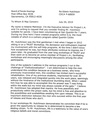
|
2019 aug 26

|
2019 aug 9
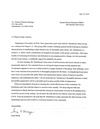
|
2019 jul 13

|
2019 jul 13

|
More... |
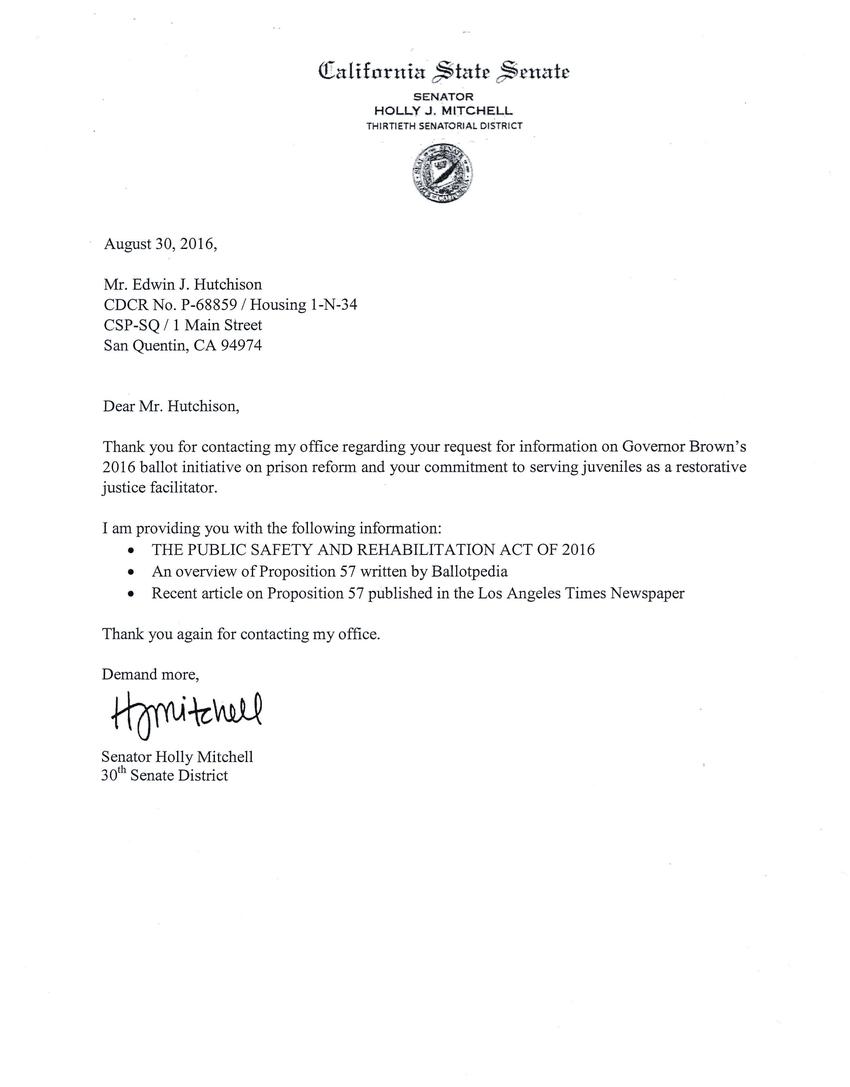
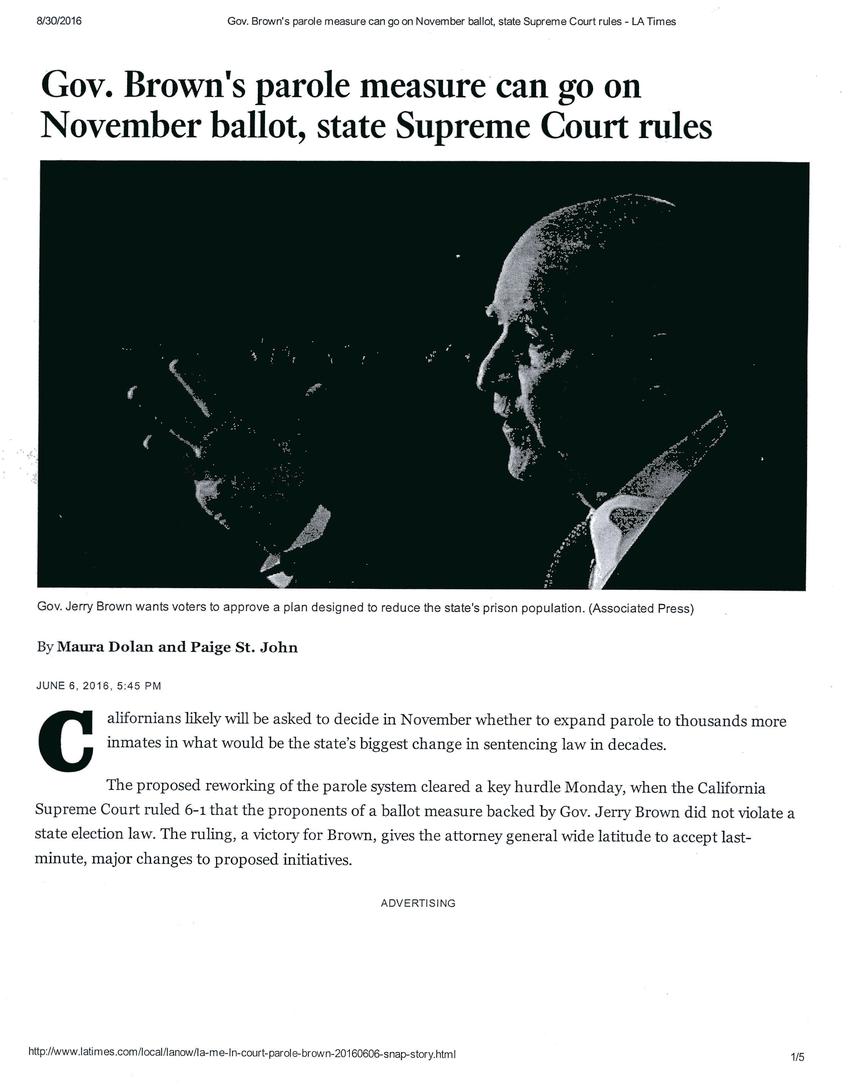
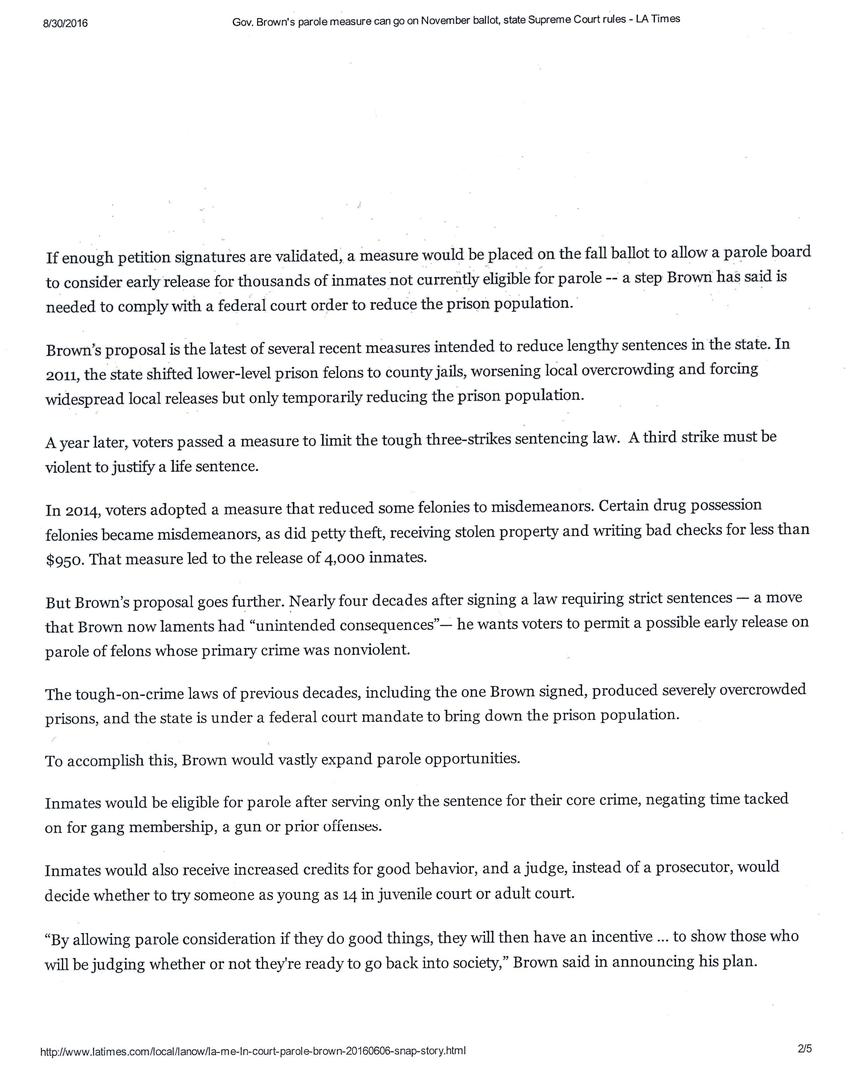

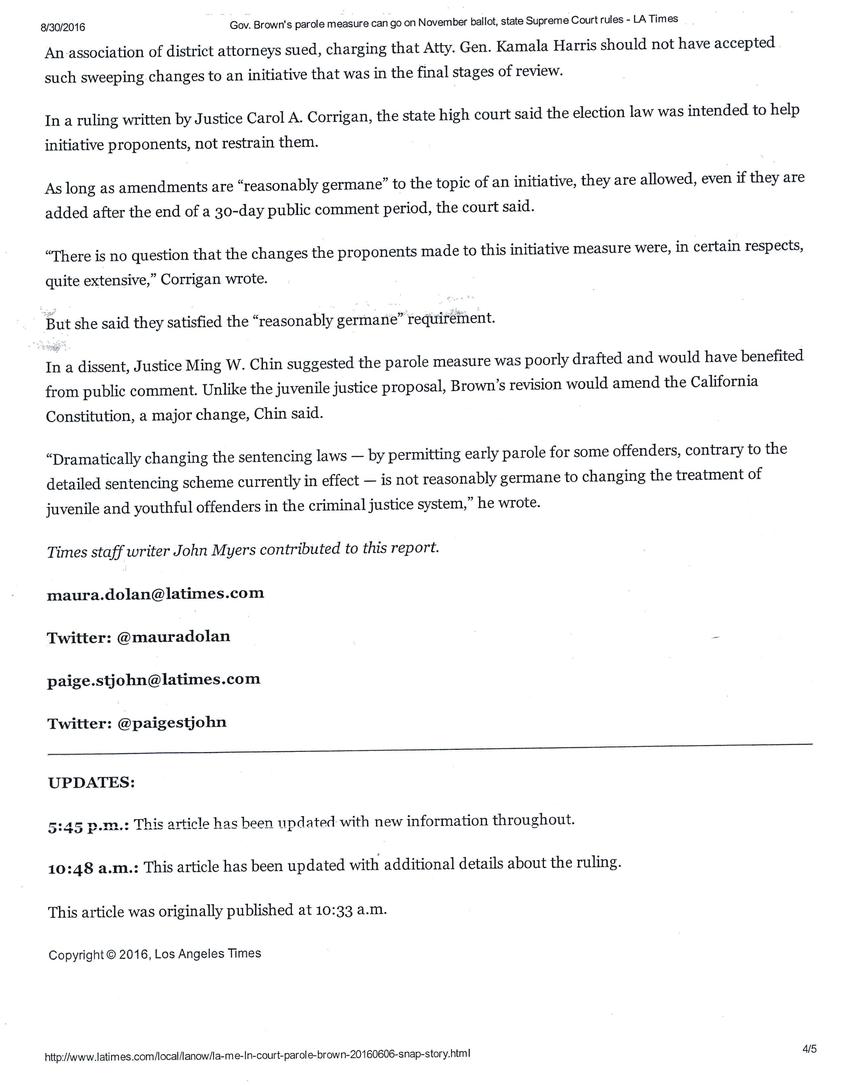
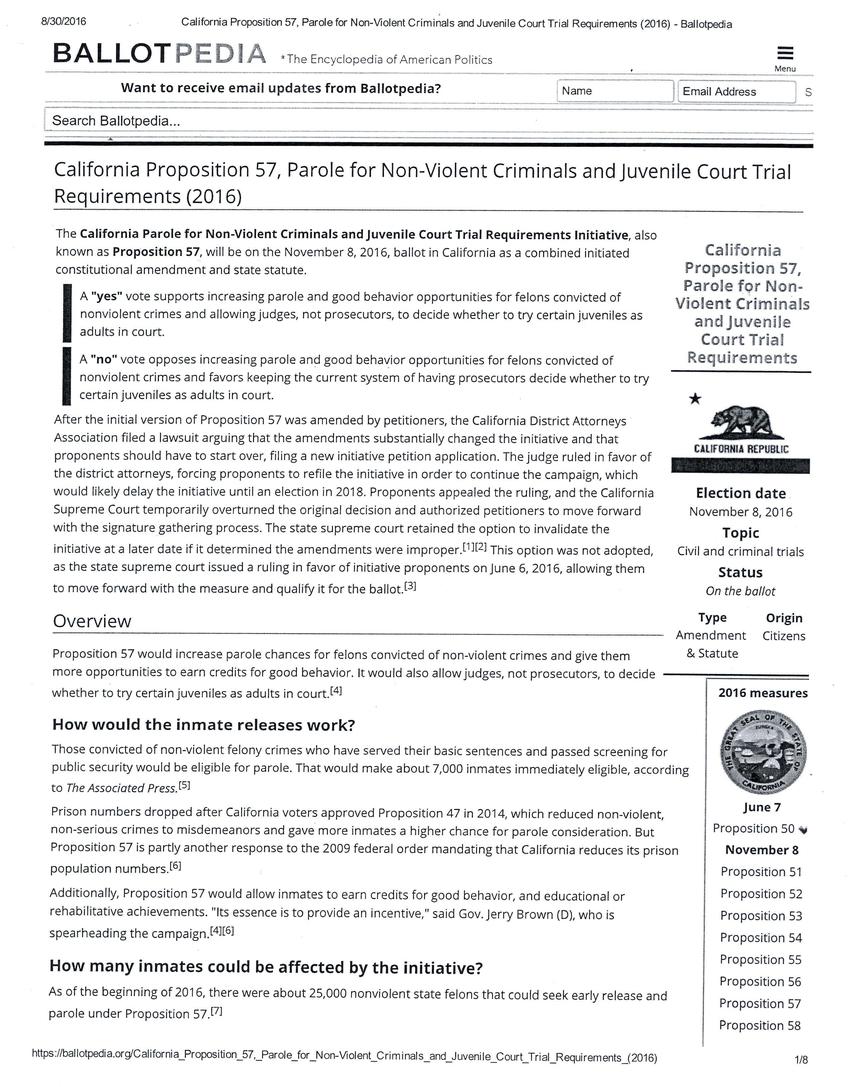

Replies